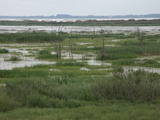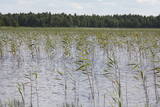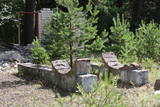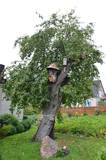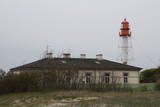| Nr | Nosaukums | Apraksts |
|---|---|---|
|
Skatu tornis uz pontoniem, kuru ar sauszemi savieno laipa. No tā praktiski pārskatāms viss Slokas ezers līdz pat Kauguriem, īpaši tā ziemeļdaļa. Pie torņa meklējams sēravots. Piemērots putnu vērošanai visa gada garumā, t.sk. ziemās, jo ezerā saglabājas neaizsalstoši lāsmeņi. |
||
|
Vienu kilometru garā lokveida taka, kas ved pa lielāku nacionālā parka meža masīvu, uzskatāmi attēlo Žemaitijas augstienes un tuvākās apkārtnes reljefa veidošanās vēsturi. No takas augstākā punkta – Mikitai kalna, kas ir sens pagānu upurkalns, paveras (ainaviska stiga) tālākas apkārtnes skats. Kā takas interesantākie apskates objekti ir jāmin teikām apvītais akmens ar Velna pēdu un ar akmeņiem izliktas akas paliekas. |
||
|
Rakstiskajos avotos Vihulas muiža pirmo reizi ir pieminēta 1501. g. Ziemeļu kara laikā to nopostīja, tādēļ mūsdienās redzamais muižas komplekss tapis pēc 1810. g., kad to iegādājās Aleksandrs fon Šūberts. Historisma stilā celto muižas pili pabeidza 1880. g. Šobrīd muižas kompleksā izveidota ekskluzīva viesnīca, SPA komplekss, restorāns u.c. To ieskauj parks. Muižas ēkas ir apskatāmas no ārpuses. |
||
|
Laivošanas pasākumu organizēšana, kajaku, kanoe laivu, SUP dēļu un aprīkojuma īre un pārdošana. |
||
|
Lubānas ieplakām, kas pieguļ Lubāna rietumu – dienvidrietumu daļai raksturīgi maz izmainīti mežu un purvu kompleksi, kuros ligzdo daudzas retas un aizsargājamas putnu sugas. Šeit sastopami daudzi reti un aizsargājami biotopi. Teritoriju var apskatīt "no malas", pārvietojoties pa Lubāna dambju sistēmu.
|
||
|
Uz Klāņu purvu no Muižniekiem aizved meža ceļš, kura galā ir informācijas stends un atpūtas vieta, no kurā labi pārskatāms Klāņezers. Tas veidojies Litorīnas jūras lagūnā. Dabas liegums veidots Klāņu, Dziru un Stāvu, kā arī seklā un aizaugušā Klāņezera un to apkārtnē esošo biotopu aizsardzībai. Iepazīstieties ar stendā iekļauto informāciju.
|
||
|
Lauku sētā piedāvā mājdzīvnieku, mājputnu un eksotisko maru apskati un izjādes ar poniju. Konsultācijas dārzkopībā un sīku dzīvnieku audzēšanā. Iespējams iegādāties paipalu olas, kūpinājumus, cāļus un jaunputnus. |
||
|
Kādreizējais Padomju armijas Ovīšu 521.robežapsardzības postenis mūsdienās atrodas LR Aizsardzības ministrijas īpašumā un ir civilpersonām slēgta teritorija. Tā apkārtnē kāpās ir saglabājušās atsevišķas Padomju armijas celto ēku drupas un elementi. No Ovīšiem līdz Venstpilij kāpu zonā bija izveidots tanku ceļš, kas saglabājies arī līdz mūsdienām. To pamazām pārņem mežs.
|
||
|
Baznīca šajā vietā – blakus Livonijas ordeņa pilij (nav saglabājusies) atradās jau ~ 1380. gadu. Tagad redzamais dievnams (patiesībā – atliekas) tika nopostīts pēc 2. pasaules kara un uzspridzināta 20. gs. 70. gados. Tā drupas ir iekonservētas un virs altārdaļas uzstādīts balts koka krusts. Atrodas Salaspils dienviddaļā starp Rīgas HES dambi un ūdenskrātuvi. |
||
|
Restorāns "Fon Meks" atrodas atjaunotās Liepupes muižas Lielajā zālē. Seno lauku ēdienu pagatavošanas tradīcijas apvieno ar mūsdienu kulinārijas metodēm. Sadarbojas ar zemniekiem. Zaļumus un garšaugus audzē muižas dārzā. Viesi var piedalīties ēdiena gatavošanā uz malkas plīts senatnīgā virtuvē. Latviešu virtuve: Rupjmaizes kanapē, plate ar Latvijas sieriem, lauku salāti ar zaļumiem, grilēti sezonas dārzeņi, muižas buljons, ēdieni no pašmāju zivīm, cepta cūkgaļas karbonāde, garšvielās cepts jērs. |
||
|
Pludmales bārs "Koklītes" atrodas Saulkrastu novada Zvejniekciemā pašā jūras krastā, 4 km attālumā no Saulkrastu centra. Plašs skats uz pludmali. Tiek rīkoti dažādi ūdenssporta un izklaides pasākumi. Latviešu virtuve: Aukstā zupa, cepta mencas fileja, kotletes mājas gaumē, cūkgaļas cepetis, pankūkas ar biezpienu, karamelizētas auzu pārslas. |
||
|
Par ostas izbūvi K. Valdemārs esot sapņojis jau ļoti agrā jaunībā, kā runā, - vēl bērns būdams! Taču tikai 20. gs. sākumā Rojā tika izveidota tā saucamā patversmes osta –uzbūvēts aizsargdambis jūrā 0,5 km attālumā no krasta ~ 213 m garumā. Taču tas pakāpeniski aizgāja bojā un eksistenci beidza 1933. g. 1930. gados tika uzsākti Rojas upes iztaisnošanas darbi, izmantojot Francijā ražotu zemessmēlēju “Rāpulis”, tika uzbērti vaļņi, izbūvēti akmeņu dambji un pāļu moli, kas vēlāk vairākkārtīgi pagarināti. 1932. g. zvejnieki paši saviem spēkiem izbūvēja 107 m garu molu. Ostas molu rekonstrukcija pilnībā tika pabeigta 1972. g. Kādreiz te, apvienojot piekrastes zvejnieku saimniecības, rosīgi darbojās zvejnieku kolhozs “Banga”. (Avots: Rojas TIC) |
||
|
Senākā Lietuvas ābele – augļkoks, kas ir botāniskais mantojuma objekts. Koka šķirne – mežābele. Tā ir vienīgā apsargājamā ābele Lietuvā. |
||
|
Tabivere ciems. Drumlinus veidojis ledājs un tie orientēti ledāja kustības virzienā. Pēc izskata drumlini atgādina klaipveida paugurus. No to „mugurām” paveras skaisti skati uz drumlinu lauka ainavu un ieplakās esošajiem ezeriem. Apmeklētāju centrs atrodas Äksi ciemā.
|
||
|
Padomju laikā visas bākas bija militāra statusa objekti, arī Papes bāka. Šobrīd bāku apsaimnieko Latvijas Jūras administrācija un tā ir apskatāma tikai no ārpuses.
|
||
|
"Saulrietos" (3 km no Vecpiebalgas centra), kas atrodas ainaviskā vietā - Incēnu kalnā, ir izveidots leģendārās latviešu pasakas "Kaķīša dzirnavas" autora Kārļa Skalbes (1879 - 1945) memoriālais muzejs. Tas atrodas 1926. g. celtajā dzejnieka un prozaiķa vasaras namā (pavadīja vasaras laikā no 1926. - 1944.g.) un darbojas kopš 1987. g. Blakus esošā Vaktskalna rietumu nogāzē (skaists skats uz Alaukstu) 1992. g. pārabedīja urnu ar Zviedrijā mirušā Kārļa Skalbes un viņa dzīvesbiedres - Lizetes Skalbes pelniem, kur izveidots savdabīgs piemineklis akmens laivas formā. |
||
|
Gar Grobiņas ūdenskrātuvi (Ālandes labais krasts) izveidota mūsdienīga un labiekārtota pastaigu un atpūtas vieta - promenāde, uz kuras izvietotas plāksnes ar Zentas Mauriņas un Jāņa Raiņa citātiem. No promenādes paveras labi skatu punkti uz Skābaržkalnu un Grobiņas pilsdrupām. Grobiņas ūdenskrātuves sašaurinājumā pāri Ālandei ved neliels tiltiņš, kas ir bijušā Liepājas – Aizputes šaursliežu dzelzceļa tilta ferma. |
||
|
Atrodas Stendes dienviddaļā. Piedāvā maltītes visām ēdienreizēm. Konditoreja, kulinārija. Āra terase un labiekārtota apkaime. |
||
|
Ļoti ainavisks ezers, uz kuru paveras lieliskas ainas no Vidzemes augstienes pauguriem. Te jāatceras latviešu teika par Ineša un Alauksta strīdu, kā rezultātā Inesis dabūja pliķus – salas, kurām (sešām) tāpat kā Sproģu pussalai ir dabas lieguma statuss. |
||
|
Sudrabkalni – bijusī aptieka, līdz pagājušā gadsimta astoņdesmito gadu
beigām – ambulance, vēlāk – pamatskola, tagad – privātmāja.
|
||





